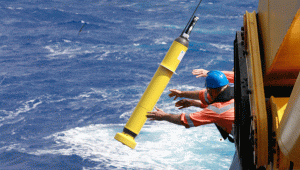Written by Neha Karl
A Bio Argo float ready to dive deep into the ocean.
Image: CSIRO
Is it a fish? Is it a boat? No, it’s Argo float – a robot ready to dive deep and collect information about the ocean!
The ocean covers more than 70% of the Earth’s surface and plays a big part in controlling global weather.The Indian Ocean is one of the main pathways by which warm water returns to the Northern hemisphere. It is also home to huge fisheries and mineral resources.
Ocean-diving robots – known as Argo floats – have been plunging to the depths of the ocean to provide scientists with important data on underwater salinity and temperatures. Now, CSIRO scientists have teamed with leading marine scientists in India to take a closer look at the Indian Ocean climate and ecosystems. To do this, the team extended the robots’ capabilities – developing new ‘Bio Argo’ floats.
These clever floats will collect data to help scientists understand what factors keep the Indian Ocean healthy. Over the next few years, dozens of floats will be released into the depths of the Indian Ocean.
Tiny sensors on the floats measure a range of factors like ocean temperature, salinity, dissolved oxygen, nitrate, and dissolved organic material. The floats will also collect information on phytoplankton cells – underwater ‘plants’ that fuel the ocean food web. This data will ultimately help scientists better understand and predict how carbon dioxide is processed by the ocean and how much food the Indian Ocean can produce.
The floats will free drift in the ocean from anywhere between the surface and 1000m depth, collecting data along the way. When each robot’s memory is full, it will emerge at the surface and send data to scientists via satellites. The floats will then dive back down into the ocean, continuing their mission for months or even years at a time.
With a new set of senses, these underwater allies are ready to embark on an exciting mission. We wish them the best of luck with their journey and hope they have a whale of a time!
If you’re after more science news for kids, subscribe to Double Helix magazine!


